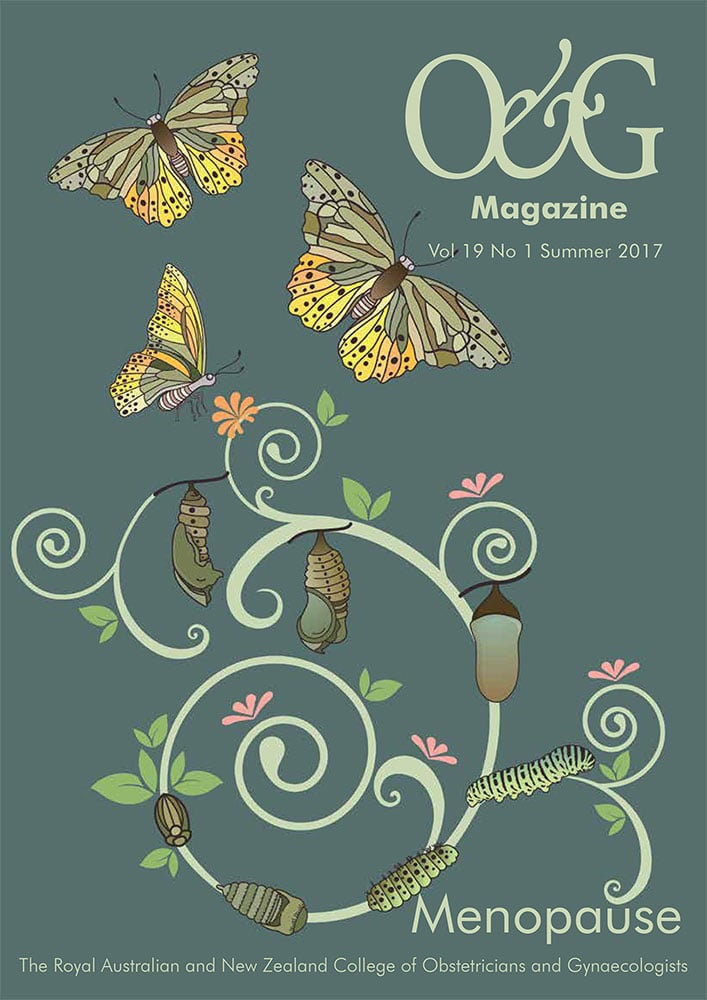Premature ovarian insufficiency (POI) is defined as the loss of normal ovarian function before the age of 40 years. Terms used synonymously for POI include premature menopause, early menopause and premature ovarian failure. Premature ovarian insufficiency is now preferred, as these other terms imply a complete loss of ovarian function, and women with POI may intermittently produce oestrogen and ovulate, 50 per cent may experience intermittent menses and 5–10 per cent appear to achieve spontaneous pregnancy.1 POI occurs in approximately 1 per cent of women2 and is characterised by menstrual disturbance (either oligomenorrhoea or amenorrhoea), raised gonadotropin levels and oestrogen deficiency (biochemical and/or clinical symptoms).
Aetiology
Most commonly, POI occurs as the result of accelerated follicle loss, resulting from genetic, autoimmune, and environmental or toxic causes. In women presenting with apparent spontaneous POI (as opposed to an identified genetic cause) an underlying cause is only identified in 10–15 per cent of cases.3 (Box 1)
Genetic
Turner syndrome (TS) (karyotype XO) is one of the most common causes of premature ovarian insufficiency. In severe cases, pubertal development is absent together with primary amenorrhea and associated defects; however, the degree of ovarian dysfunction and the extent of the defects can be variable. Other defects in the X chromosome make up the other common genetic causes of POI. In addition, there is increasing evidence for an association between pre-mutations of the FMR1 gene (Fragile X syndrome) and POI. Premature ovarian insufficiency may also be associated with other genetic syndromes (for example, blepharophimosis/ptosis/epicanthus inversus syndrome [BPES], which is associated with mutations in the FOXL2 gene4). Some rare genetic disorders may present with primary hypogonadism without follicle depletion, in which genetic disorders of oestradiol precursor production or aromatase function result in decreased oestradiol and absence of normal follicle-stimulating hormone (FSH) negative feedback).5 6 As our knowledge of genes involved in ovarian function expands, it is likely that a greater proportion of ‘spontaneous’ POI will be able to be attributed to genetic abnormalities.
Non-genetic
Non-genetic causes of premature ovarian insufficiency include autoimmune syndromes and ovarian toxins. Autoimmune ovarian failure can occur as part of type I and type II syndromes of polyglandular autoimmune failure, in which there are autoantibodies to multiple endocrine, and other, organs. Premature ovarian insufficiency may also be associated with isolated adrenal insufficiency (approximately 3 per cent of women with spontaneous POI develop adrenal insufficiency).7 The frequency of autoimmune oophoritis in women without coexisting adrenal failure is not known. POI may occur as a result of bilateral oophorectomy (surgical menopause), or after the ovaries have been exposed to ovarian toxins such as chemotherapy (Box 1) and/or radiotherapy. Viral oophoritis has not been systematically demonstrated to be a cause of POI, although there is some evidence for a potential role as an ovarian toxin from animal models and case reports.8 9 10 POI is common in women with galactosaemia, and even minor defects in galactose metabolism may adversely affect ovarian function.11
Clinical presentation
Frequently the diagnosis of POI is delayed, which may relate both to a lack of awareness that ovarian failure occurs in younger women and because intermittent ovarian function occurs in approximately 50–75 per cent of women with spontaneous POI.12 13 14 On average, a woman with POI will present to three medical practitioners before the diagnosis of POI is confirmed.15
History
Premature ovarian insufficiency should be suspected when there is menstrual irregularity of four or more months’ duration, particularly if oestrogen deficiency symptoms (vasomotor flushes, vaginal dryness, night sweats, fatigue and mood changes) are also present. POI may also present with primary amenorrhoea, with or without a delay in pubertal development. Additional features in the history include predisposing factors such as prior surgery, chemotherapy or radiation treatment, or features associated with an autoimmune or genetic syndrome. A family history of POI may give an indication of aetiology, as 10 per cent of cases are familial.16 Similarly, a family history of Fragile X syndrome, mental retardation, developmental delay, Parkinsonism, intention tremor, ataxia or dementia may indicate the presence of a pre-mutation in the FMR1 gene.17
- Turner syndrome (TS)
- Other defects in the X chromosome
- Pre-mutation FMR1 gene
- Somatic gene mutations (e.g. BPES, mutations in FOXL2 gene)
- Genetic causes of primary hypogonadism without ovarian follicle depletion (e.g. mutations in genes affecting BMP15, inhibin, CYP17, StAR, FSH receptor, Gs alpha subunit)
Autoimmune oophoritis
- Isolated
- Associated with Addison’s disease or polyglandular syndrome
Ovarian toxin
- Chemotherapy (e.g. alkylating agents, methotrexate, 6 mercaptopurine, actimomycin and adriamycin)
- Radiation (typically megavoltage irradiation [4500–5000 rads])
- Galactosaemia
- Infection (e.g. mumps)
Surgery
- Oophorectomy
- Other (e.g. hysterectomy)
Box 1. Aetiology of POI.
Physical examination
Most women with spontaneous premature ovarian insufficiency have unremarkable clinical findings. However, it is important to examine for signs of associated conditions, in particular, adrenal insufficiency, hypothyroidism and TS.
Investigation and diagnosis
The diagnosis of premature ovarian insufficiency is readily confirmed by the finding of an elevated FSH in association with low oestradiol levels. A repeat measurement should be made after at least four weeks to confirm the diagnosis. Once the diagnosis is confirmed, tests to clarify aetiology and to assess for associated syndromes should be undertaken. A standard investigation in a woman with spontaneous POI would routinely include the following tests.
Aetiology
A karyotype should be performed as a part of the routine evaluation. In addition, professional bodies recommend women undergo testing for a pre-mutation in FMR1.18 19 Adrenal antibodies should be measured, and if positive, an ACTH stimulation test should be performed to exclude Addison’s disease. There are no reliable ovary-specific antibody tests for the diagnosis of autoimmune ovarian failure.
Associated conditions
Women with TS need referral to an endocrinologist as this syndrome is associated with many comorbidities. It is reasonable to perform a limited screen for polyglandular autoimmune failure: serum free T4, thyroid-stimulating hormone (TSH), thyroid peroxidase antibodies, HbA1c and an 8am cortisol when no clear aetiology of POI has been identified.
Premature ovarian insufficiency management
Psychological support
For women with a diagnosis of POI, immediate concerns include loss of fertility, oestrogen-deficiency symptoms and the psychological distress of the diagnosis, particularly if the diagnosis has been delayed and the patient is nulliparous. Face-to-face consultation to inform a patient of the diagnosis is mandatory, and several appointments may be required to provide information about POI at a pace suited to the woman’s prior health education and concerns. Patients should be provided with educational resources and support. Parents of younger patients may experience considerable grief and loss when faced with the diagnosis of POI and its implications for future generations, thus support for the wider family is also of importance. In an optimal situation, there should be access to multidisciplinary care, including gynaecology, psychology, fertility services and endocrinology, experienced in management of this condition and use of hormone replacement therapy (HRT).
Hormone replacement therapy
In the absence of an absolute contraindication to taking oestrogen therapy, it is recommended that women with POI receive HRT (in almost all cases with a progestin, as most of these patients have an intact uterus).20 Good-quality data concerning the efficacy of HRT in women with POI are limited; however, an increasing number of observational studies support the likely beneficial effects of HRT in women to prevent bone loss, and potentially to reduce cardiovascular disease and prevent dementia.21 The current approach is to treat with a hormone replacement regimen that resembles normal physiology until the average age of natural menopause (age 50–51 years). The potential benefits of HRT should be discussed with all women; those closer to 40 years of age and without symptoms may not wish to commence HRT.
Data are inconclusive regarding the relative merits of the combined oral contraceptive pill (COCP) compared to oral or transdermal HRT. Both are likely to treat oestrogen deficiency symptoms. HRT is a combination of natural oestrogen with a synthetic progestin, intrauterine progestin or natural progesterone. HRT provides physiological oestrogen replacement and is not contraceptive. The COCP contains synthetic oestrogen and is therefore contraceptive, which may be advantageous for some women; in NZ it is more cost-effective. Younger women may find it more acceptable to be on a medication indistinguishable from their peers. Disadvantages of the COCP include the possibility that the risk of venous thromboembolism (VTE) may be greater compared to transdermal HRT preparation and recurrent symptoms when using the inactive tablets. Limited trials suggest a modest advantage of HRT over the COCP for prevention of bone loss.22
Although migraine is not a contraindication to HRT, a transdermal preparation may be preferred in this setting. Prior history of VTE, stroke or myocardial infarction are relative contraindications to oestrogen therapy (ET), but low dose transdermal ET could be considered in consultation with the relevant specialist if benefits were considered to outweigh risks. Women with treated ovarian cancer or low-risk endometrial cancer and menopausal symptoms may be considered for hormone therapy, but non-hormonal options are preferable in women with intermediate-risk or high-risk endometrial cancer. A history of breast cancer is a relative contraindication to HRT and other options are preferred (see www.cancer australia.gov.au/management of menopausal symptoms after breast cancer). BRCA1 and BRCA2 gene mutation carriers without a personal history of cancer may be considered for HRT following bilateral salpingoophorectomy (BSO). A prospective cohort found that HRT did not negate the beneficial effect of BSO on breast cancer risk.23 24
Oestrogen is the most effective treatment for moderate to severe symptoms of vaginal atrophy and can take the form of systemic or vaginal ET. A meta-analysis found vaginal ET to be more effective than systemic therapy for treatment of vaginal atrophy.25 Non-hormonal vaginal moisturisers are the first line of treatment of vaginal atrophy in women with breast cancer.26
Androgen replacement
The role of androgen therapy is limited to treatment of sexual dysfunction. Systemic testosterone is associated with improvements in some domains of sexual function (number of satisfying sexual episodes and interest in sex).27 Recent guidelines suggest against the routine use of dehydroepiandrosterone (DHEA) for sexual function (or other indications) in menopausal women because of its limited efficacy and lack of long-term safety data.28
Non-hormonal options
Options for oestrogen deficiency symptoms in women with POI where oestrogen therapy is contraindicated include selective serotonin reuptake inhibitors (SSRIs), serotonin-norepinephrine reuptake inhibitors (SNRIs), anti-epileptics and centrally acting drugs.
Managing the consequences of POI
The primary clinician needs to be appropriately informed of the sequelae of POI, particularly infertility, reduced bone mineral density and increased fracture risk later in life, negative impact on psychological wellbeing and quality of life, and potential detrimental effects on cognition.29 Untreated, POI is associated with reduced life expectancy, largely due to cardiovascular disease, thus smoking cessation and regular assessment of blood pressure, diabetes parameters and lipids should be undertaken, and a ‘cardiac friendly’ lifestyle should be encouraged. Oestrogen deficiency associated with POI is an important risk factor for bone loss, osteoporosis and fracture.29-3130 31 32 At the time of diagnosis, a bone density scan (dual-energy x-ray absorptiometry [DXA]) should be obtained. Women desirous of fertility need support for the loss of fertility, information about the possibility that spontaneous conception may still occur and need to be informed of options to conceive. Oocyte donation remains the best current option to facilitate fertility. In NZ, women need to be under 40 years old, a NZ resident, a non-smoker, and have a body mass index (BMI) under 32 to be eligible for funded oocyte donation. Genetic counselling should be offered to those women with family history of POI, a pre-mutation of the FMR1 gene or other identified genetic abnormalities. If fertility is contemplated in a woman with TS, assessment of current cardiac, endocrine and gynaecology status is mandatory.
Recommendations for follow up
Once the diagnosis is established and a decision is made regarding the use of HRT, ongoing review remains important. Initially, frequent review (three months after commencing HRT) is important to assess medication use (including compliance) and to review suitability of the current treatment regimen. Once an appropriate treatment regimen is established, annual follow up is recommended to monitor HRT use and suitability, assess psychological health and fertility status, and to assess bone and cardiovascular health. Current guidelines recommend bone density measurement after five years as an assessment of compliance in HRT users, and to monitor bone health in those not using HRT.33 Women should be assessed for symptoms and signs of thyroid disease and adrenal insufficiency and repeat investigation considered. Any woman who has positive adrenal antibodies on initial evaluation is at high risk of developing adrenal insufficiency and should have an annual ACTH stimulation test. Women with TS need particular attention to follow up. The requirement and frequency of screening mammography is determined by other risk factors for breast cancer.
References
- van Kasteren YM, Schoemaker J. Premature ovarian failure: a systematic review on therapeutic interventions to restore ovarian function and achieve pregnancy. Hum Reprod Update. 1999;5(5):483-92.
- Committee opinion no. 502: primary ovarian insufficiency in the adolescent. Obstet Gynecol. 2011;118(3):741-5.
- Nelson LM. Clinical practice. Primary ovarian insufficiency. N Engl J Med. 2009;360(6):606-14.
- Beysen D, De Paepe A, De Baere E. FOXL2 mutations and genomic rearrangements in BPES. Hum Mutat. 2009;30(2):158-69.
- Shelling AN, Burton KA, Chand AL, et al. Inhibin: a candidate gene for premature ovarian failure. Hum Reprod. 2000;15(12):2644-9.
- Lourenco D, Brauner R, Lin L, et al. Mutations in NR5A1 associated with ovarian insufficiency. N Engl J Med. 2009;360(12):1200-10.
- Bakalov VK, Vanderhoof VH, Bondy CA, Nelson LM. Adrenal antibodies detect asymptomatic auto-immune adrenal insufficiency in young women with spontaneous premature ovarian failure. Hum Reprod. 2002;17(8):2096-100.
- Williams DJ, Connor P, Ironside JW. Pre-menopausal cytomegalovirus oophoritis. Histopathology. 1990;16(4):405-7.
- Subietas A, Deppisch LM, Astarloa J. Cytomegalovirus oophoritis: ovarian cortical necrosis. Hum Pathol. 1977;8(3):285-92.
- Smith PC, Nusbaum KE, Kwapien RP, Stringfellow DA, Driggers K. Necrotic oophoritis in heifers vaccinated intravenously with infectious bovine rhinotracheitis virus vaccine during estrus. Am J Vet Res. 1990;51(7):969-72.
- Chen YT, Mattison DR, Feigenbaum L, Fukui H, Schulman JD. Reduction in oocyte number following prenatal exposure to a diet high in galactose. Science. 1981;214(4525):1145-7.
- Taylor AE, Adams JM, Mulder JE, et al. A randomized, controlled trial of estradiol replacement therapy in women with hypergonadotropic amenorrhea. J Clin Endocrinol Metab. 1996;81(10):3615-21.
- Nelson LM, Anasti JN, Kimzey LM, et al. Development of luteinized graafian follicles in patients with karyotypically normal spontaneous premature ovarian failure. J Clin Endocrinol Metab. 1994;79(5):1470-5.
- Hubayter ZR, Popat V, Vanderhoof VH, et al. A prospective evaluation of antral follicle function in women with 46,XX spontaneous primary ovarian insufficiency. Fertil Steril. 2010;94(5):1769-74.
- Alzubaidi NH, Chapin HL, Vanderhoof VH, Calis KA, Nelson LM. Meeting the needs of young women with secondary amenorrhea and spontaneous premature ovarian failure. Obstet Gynecol. 2002;99(5 Pt 1):720-5.
- van Kasteren YM, Hundscheid RD, Smits AP, et al. Familial idiopathic premature ovarian failure: an overrated and underestimated genetic disease? Hum Reprod. 1999;14(10):2455-9.
- Marozzi A, Vegetti W, Manfredini E, et al. Association between idiopathic premature ovarian failure and fragile X premutation. Hum Reprod. 2000;15(1):197-202.
- Sherman S, Pletcher BA, Driscoll DA. Fragile X syndrome: diagnostic and carrier testing. Genet Med. 2005;7(8):584-7.
- American College of Obstetricians and Gynecologists Committee on Genetics. ACOG committee opinion. No. 338: Screening for fragile X syndrome. Obstet Gynecol. 2006;107(6):1483-5.
- European Society for Human R, Embryology Guideline Group on POI, Webber L, Davies M, Anderson R, et al. ESHRE Guideline: management of women with premature ovarian insufficiency. Hum Reprod. 2016;31(5):926-37.
- Hogervorst E, Bandelow S. Sex steroids to maintain cognitive function in women after the menopause: meta-analyses of treatment trials. Maturitas. 2010;66(1):56-71.
- Cartwright B, Robinson J, Seed PT, Fogelman I, Rymer J. Hormone Replacement Therapy Versus the Combined Oral Contraceptive Pill in Premature Ovarian Failure: A Randomized Controlled Trial of the Effects on Bone Mineral Density. J Clin Endocrinol Metab. 2016;101(9):3497-505.
- Rebbeck TR, Friebel T, Wagner T, et al. Effect of short-term hormone replacement therapy on breast cancer risk reduction after bilateral prophylactic oophorectomy in BRCA1 and BRCA2 mutation carriers: the PROSE Study Group. J Clin Oncol. 2005;23(31):7804-10.
- Domchek SM, Friebel TM, Singer CF, et al. Association of risk-reducing surgery in BRCA1 or BRCA2 mutation carriers with cancer risk and mortality. JAMA. 2010;304(9):967-75.
- Cardozo L, Bachmann G, McClish D, Fonda D, Birgerson L. Meta-analysis of estrogen therapy in the management of urogenital atrophy in postmenopausal women: second report of the Hormones and Urogenital Therapy Committee. Obstet Gynecol. 1998;92(4 Pt 2):722-7.
- American College of Obstetricians and Gynecologists Committee on Genetics. Farrell R. ACOG Committee Opinion No. 659: The Use of Vaginal Estrogen in Women With a History of Estrogen-Dependent Breast Cancer. Obstet Gynecol. 2016;127(3):e93-6.
- Elraiyah T, Sonbol MB, Wang Z, et al. Clinical review: The benefits and harms of systemic testosterone therapy in postmenopausal women with normal adrenal function: a systematic review and meta-analysis. J Clin Endocrinol Metab. 2014;99(10):3543-50.
- Wierman ME, Arlt W, Basson R, et al. Androgen therapy in women: a reappraisal: an Endocrine Society clinical practice guideline. J Clin Endocrinol Metab. 2014;99(10):3489-510.
- European Society for Human R, Embryology Guideline Group on POI, Webber L, Davies M, Anderson R, et al. ESHRE Guideline: management of women with premature ovarian insufficiency. Hum Reprod. 2016;31(5):926-37.
- Leite-Silva P, Bedone A, Pinto-Neto AM, Costa JV, Costa-Paiva L. Factors associated with bone density in young women with karyotypically normal spontaneous premature ovarian failure. Arch Gynecol Obstet. 2009;280(2):177-81.
- De Vos M, Devroey P, Fauser BC. Primary ovarian insufficiency. Lancet. 2010;376(9744):911-21.
- Gallagher JC. Effect of early menopause on bone mineral density and fractures. Menopause. 2007;14(3 Pt 2):567-71.
- Cartwright B, Robinson J, Seed PT, Fogelman I, Rymer J. Hormone Replacement Therapy Versus the Combined Oral Contraceptive Pill in Premature Ovarian Failure: A Randomized Controlled Trial of the Effects on Bone Mineral Density. J Clin Endocrinol Metab. 2016;101(9):3497-505.







Leave a Reply